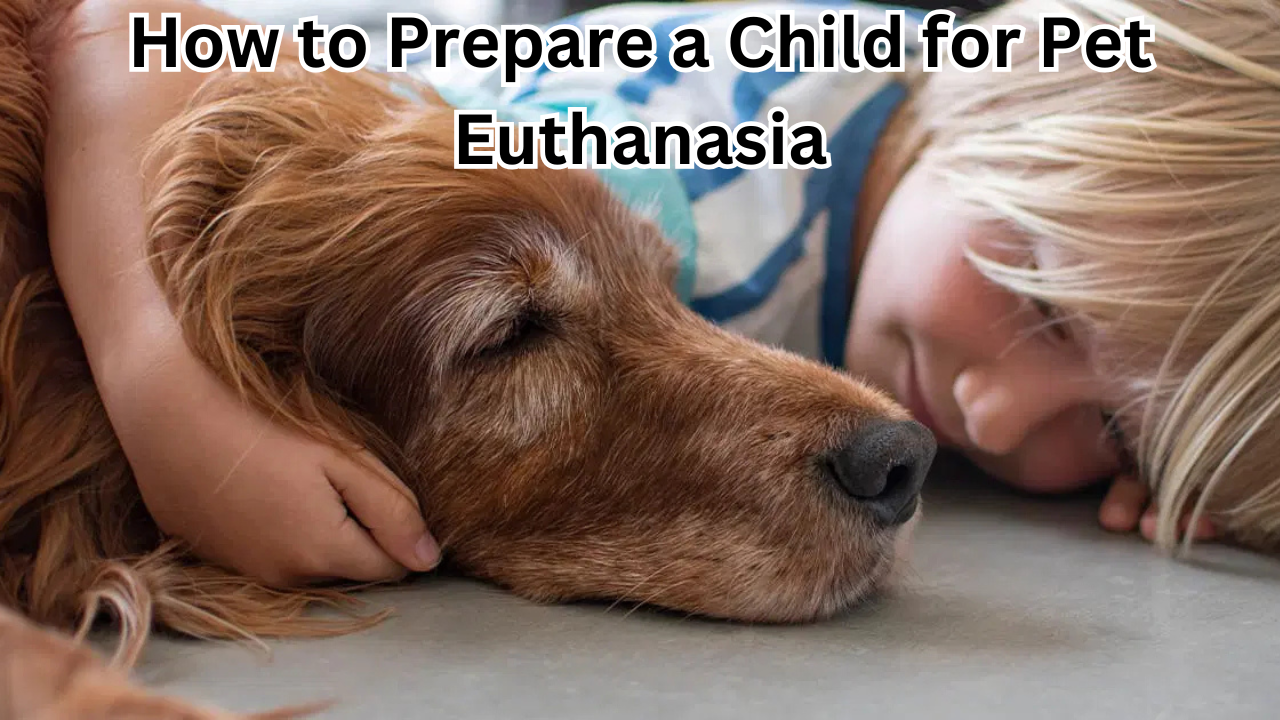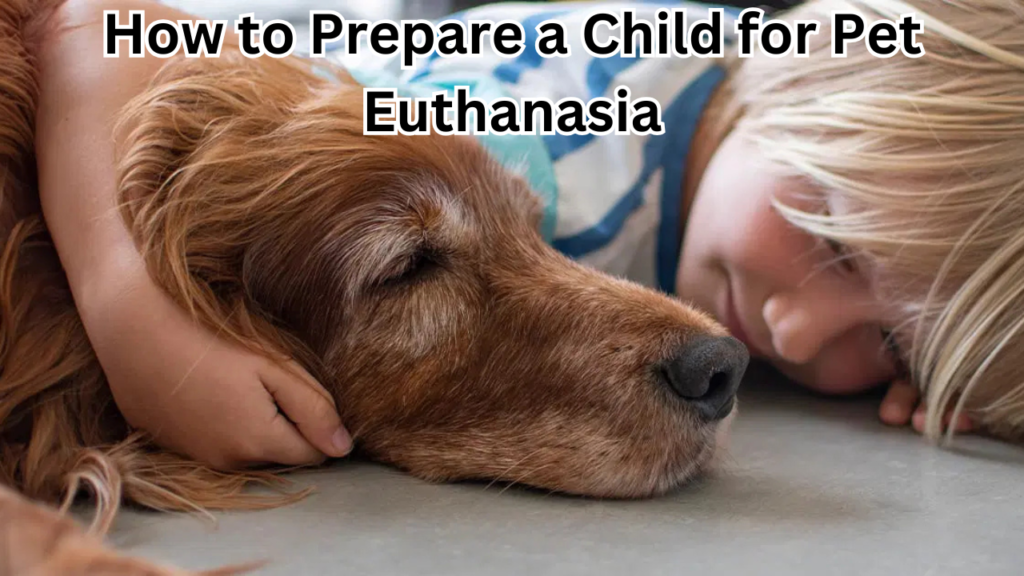

Table of Contents
Introduction
Preparing a child for the emotional experience of pet euthanasia can be incredibly challenging for both parents and children. The loss of a beloved pet can stir up complex emotions, making it difficult for a child to fully understand what is happening. As a parent, it is essential to approach the situation with care and sensitivity, ensuring that your child receives the support they need to process their emotions. This article will explore how to prepare a child for pet euthanasia, offering age-appropriate guidance and tips for making this difficult moment as compassionate and understanding as possible. By addressing the situation with honesty and empathy, parents can help their children cope with the impending loss while providing the comfort and reassurance they need during such a sensitive time.
Understanding Pet Euthanasia
Pet euthanasia is the process of intentionally ending a pet’s life to prevent suffering, typically due to a terminal illness, severe injury, or a condition that causes chronic pain. While the decision is often one of the hardest a pet owner can make, it can be considered humane when a pet’s quality of life has significantly deteriorated, and they are no longer able to enjoy their usual activities or are in constant discomfort. The goal of euthanasia is to prevent unnecessary pain and ensure a peaceful passing.
When preparing a child for pet euthanasia, it’s important to explain the process with honesty, but also with age-appropriate language. For instance, how to explain putting a dog down to a child can be done by describing how the veterinarian will help the pet sleep peacefully, ending their pain. For older children, it may be necessary to explain more about the medical reasons behind the decision. Additionally, how to explain behavioral euthanasia to a child can involve discussing situations where pets and animals may become dangerous or extremely distressed, and euthanasia is considered the kindest option for both the pet and the family. Taking the time to answer questions and provide emotional support is crucial in helping your child understand the difficult decision.
Should a Child Be Present During Euthanasia?
The decision of whether or not a child should be present during pet euthanasia is deeply personal and depends on various factors, including the child’s age, emotional maturity, and the nature of the pet’s condition. There are both pros and cons to consider when deciding should a child be present during euthanasia.
One of the main advantages of having a child present is the opportunity for them to say goodbye and understand the process in a real and meaningful way. It can provide closure and help children comprehend the concept of life and death in a healthy, age-appropriate manner. Being present may also help children cope with feelings of guilt or confusion, knowing they were there to comfort their pet in its final moments.
On the other hand, there are potential drawbacks to having a child present. The emotional impact of witnessing the euthanasia process can be overwhelming, especially for younger children who may struggle to fully grasp the situation. It can be distressing for children to see their pet in a vulnerable state, and the experience might leave them with lasting emotional discomfort. It’s important to assess how emotionally ready the child is, as some children may find the event traumatic, while others might be more resilient.
Ultimately, the decision should be based on your child’s emotional readiness and ability to process the experience. It may be helpful to discuss the situation with your child beforehand and gauge their comfort level with the idea of being present. In some cases, it might be better for the child to say goodbye in a quieter setting, allowing them to process the loss without witnessing the actual procedure.
Explaining Pet Euthanasia to a Child
When explaining pet euthanasia to a child, it’s important to use language that is simple, honest, and compassionate. Children, especially younger ones, may struggle to understand the complexities of death and euthanasia, so it’s crucial to communicate in an age-appropriate way. This can help them process the situation and cope with their emotions.
For younger children, avoid using euphemisms like “putting to sleep,” which might confuse them. Instead, explain that the pet’s body is no longer working properly, and the veterinarian will help them stop suffering. Use clear, gentle words, such as, “Your pet is very sick and can’t get better, and we need to help them not hurt anymore.” This approach provides honesty without overwhelming them with too much detail.
For older children, it may be appropriate to discuss the medical reasons behind the decision in more detail. Be honest about the fact that pets can suffer from illnesses or injuries that cannot be fixed. Encourage them to ask questions and give age-appropriate answers. It’s important to be open and reassure them that euthanasia is a way to ensure the pet’s peace and comfort.
In cases where when a pet dies suddenly, a child may struggle with the shock and confusion of an unexpected loss. It’s important to validate their feelings and provide comfort, explaining that sometimes pets can pass away without warning due to illness or old age. This can help children understand that the pet’s death wasn’t anyone’s fault and that it is a natural part of life, even though it’s painful.
Additionally, when discussing how to explain behavioral euthanasia to a child, be sensitive to the child’s feelings. If a pet is being euthanized due to dangerous behavior or extreme distress, it’s essential to explain that the decision was made to prevent further suffering, both for the pet and for the family. Reassure the child that the choice was made with love and the pet’s well-being in mind. Handling this topic with care can help children understand that euthanasia isn’t just about death—it’s about making the kindest choice for a suffering animal.
Preparing a Child for Saying Goodbye
Saying goodbye to a beloved pet is never easy, especially for a child. One of the most common questions parents face during this time is should a child say goodbye to a pet before they pass away. While this decision ultimately depends on the child’s emotional maturity, allowing them to say goodbye can be an important part of the healing process. For many children, having the opportunity to express their feelings and give their pet a final moment of love provides a sense of closure and helps them understand the concept of loss.
To make this moment meaningful, you can create rituals that allow the child to honor their pet. For example, encourage them to write a letter or draw a picture for their pet, expressing their love and saying goodbye. This can be a therapeutic activity, giving the child a way to process their emotions and feel connected to their pet in their final moments. Some families also create a small ceremony or ritual, such as lighting a candle, sharing a favorite memory of the pet, or simply spending quiet time together. These moments can help the child feel involved in the process and bring comfort during a difficult time.
Ultimately, whether or not a child should say goodbye to a pet depends on their emotional readiness and the circumstances surrounding the euthanasia. Some children may feel empowered by the opportunity to say their goodbyes, while others may prefer to say farewell in their own way, in their own time. It’s important to offer support and guidance, helping the child express their feelings in a way that feels right for them.
Supporting a Child Before, During, and After Euthanasia
Supporting a child through the process of pet euthanasia requires thoughtful preparation and ongoing care. How to prepare kids for pet euthanasia involves helping them understand what is happening in an age-appropriate way and ensuring they feel emotionally supported. The first step is to prepare them emotionally by discussing the pet’s illness and the upcoming decision with honesty and compassion. It’s important to use language that aligns with the child’s developmental stage and to answer any questions they may have. This approach allows the child to anticipate the event and process their feelings before the actual euthanasia takes place.
If euthanasia is happening at home, how to prepare a child for pet euthanasia at home might involve making the environment as calm and comforting as possible. Let the child know what to expect in advance, explaining the process of how the veterinarian will help the pet peacefully pass away. It’s important to reassure them that their pet will not be in pain and that they will be with them in their final moments, if they choose to be present.
During the event, comforting the child is crucial, especially if they are present. Offering physical comfort, such as holding their hand or providing a soft hug, can help them feel secure. Keep the atmosphere calm and reassuring, emphasizing that the decision was made out of love to end their pet’s suffering. Reassure the child that it is okay to feel sad or confused and that it is a normal part of the process.
After the euthanasia, how to support a child when a pet dies involves offering ongoing emotional support. The grieving process doesn’t end immediately, so it’s important to check in with the child regularly to see how they’re coping. One way to help the child heal is by memorializing the pet together. You can create a memory box, plant a tree, or make a scrapbook with pictures and mementos of their pet. This can help the child remember their pet fondly and celebrate the joy the pet brought to their life.
It’s also important to monitor the child’s emotional health in the weeks following the pet’s death. Some children may experience waves of sadness, guilt, or confusion. Be open to talking about the pet and how they’re feeling, while also recognizing when they may need extra support, whether from a counselor or support group. With patience and understanding, parents can guide their child through the grieving process, helping them navigate this difficult experience in a healthy and supportive way.
Resources for Parents and Caregivers
Navigating the difficult process of preparing a child for pet euthanasia can be challenging, and having the right resources can provide additional support and guidance. There are a variety of helpful materials available, including books, videos, and downloadable PDFs, that can assist parents and caregivers in talking to their children about the loss of a pet.
One of the best ways to guide a child through this experience is by reading age-appropriate books that explain pet loss and euthanasia in a compassionate and accessible way. Books such as The Tenth Good Thing About Barney by Judith Viorst and Goodbye, Friend: Healing Wisdom for Anyone Who Has Ever Lost a Pet by Gary Kowalski provide comforting narratives that can help children understand and process their grief. These books can also offer parents a framework for discussing pet euthanasia with their children in an honest and supportive way.
Additionally, watching videos that address pet loss and euthanasia can be helpful for children who may need a visual or more engaging way to understand the process. There are a variety of family-friendly videos available online that gently explain pet euthanasia and its role in preventing suffering.
For parents who are looking for more detailed information or guides, resources like How to Prepare a Child for Pet Euthanasia PDF are available online. These PDFs often include step-by-step instructions, tips for talking to children about loss, and strategies for managing emotions before, during, and after euthanasia. These resources can be an invaluable tool for parents seeking guidance and reassurance during a difficult time.
Having these resources at hand can offer additional support and help parents feel more prepared to navigate the challenging process of preparing a child for the loss of a pet. Whether it’s through reading, watching videos, or using downloadable materials, these resources can make a significant difference in helping both parents and children process their grief in a healthy and understanding way.
Conclusion
Navigating the loss of a beloved pet is one of the most challenging experiences a family can face, especially when it comes to how to prepare a child for pet euthanasia. Throughout this process, it’s essential to approach the situation with honesty, empathy, and age-appropriate guidance. By being open about the pet’s condition and offering comforting, simple explanations, parents can help their child understand what is happening in a way that honors their emotional needs. Providing support through rituals, conversations, and ongoing care can help a child process their grief and find closure.
However, it’s important to recognize that every child will grieve differently, and some may need additional support. If necessary, don’t hesitate to seek professional help, whether it be from a counselor, pediatric therapist, or grief specialist, to ensure your child has the resources they need to cope. Offering them the space and support to express their feelings can make all the difference in helping them heal after the loss of a cherished pet.
FAQs
1. What to do if a child refuses to say goodbye to a pet?
If a child refuses to say goodbye to a pet, it’s important to acknowledge and validate their feelings. Sometimes, children may struggle with the finality of saying goodbye and may not feel ready. You can encourage them to express their emotions in other ways, such as through writing a letter, drawing a picture, or sharing a special memory of the pet. Respect their choice, but also ensure they understand that it’s okay to feel upset and that saying goodbye is a personal decision. In the case of how to prepare a child for pet euthanasia, make sure the child knows they can choose the way that feels most comfortable for them.
2. How to talk about pet euthanasia with young children vs. teenagers?
When talking to young children about pet euthanasia, it’s essential to use simple, straightforward language. Focus on the idea that the pet is very sick and the veterinarian is helping them stop suffering. Avoid overwhelming them with too much detail. For teenagers, you can have a more open and detailed conversation, explaining the medical reasons for euthanasia and involving them in the decision-making process if appropriate. Tailor the conversation based on how to prepare a child for pet euthanasia according to their age and emotional readiness.
3. How to explain the concept of euthanasia to a child who has never experienced death before?
Explaining euthanasia to a child who has never experienced death can be challenging, but it’s important to be gentle and honest. You can explain that sometimes animals get very sick, and doctors can’t fix them, so they help the pet to pass away peacefully so they won’t feel pain anymore. Emphasize that it’s not the child’s fault and that the decision is made out of love to prevent suffering. For a child who is unfamiliar with death, it can be helpful to connect the concept of euthanasia to something they understand, like a pet feeling unwell and needing comfort. This is part of how to prepare a child for pet euthanasia with compassion and clarity.
4. Can attending pet euthanasia help with a child’s grieving process?
Attending pet euthanasia can be a helpful part of the grieving process for some children, as it allows them to say goodbye and understand the situation more clearly. It can provide closure and help the child process their emotions. However, not all children are emotionally ready to witness euthanasia, and it’s important to gauge their comfort level. If the child chooses not to attend, offering other ways to say goodbye—like writing a letter or having a private moment with the pet—can still support their emotional needs. When considering how to prepare a child for pet euthanasia, it’s essential to consider the child’s emotional maturity and readiness to handle the experience.




